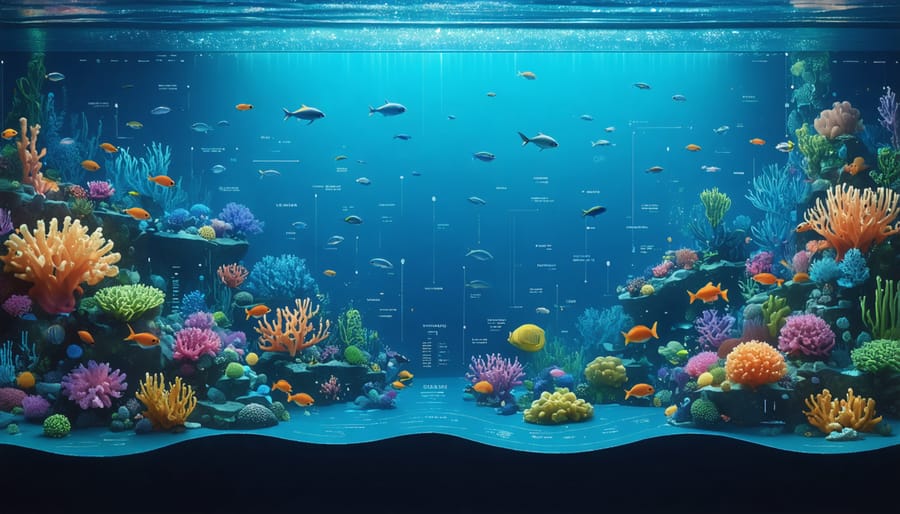The Hidden Patterns Behind Technology
Computational fluid dynamics reveals to us the unseen patterns of air movement that are as crucial to modern server rooms as ocean currents are to coral reefs. In both realms, the flow of molecules—whether water or air—determines survival. When we observe a data centre from this perspective, we begin to appreciate it not merely as a technological construct but as an ecosystem with its own delicate balances and interdependencies. The constant exchange of heat energy, the invisible thermal gradients, and the subtle movements of cooling air form patterns that would be immediately recognisable to a student of natural systems.
“In Singapore’s tropical climate, proper application of computational fluid dynamics isn’t merely beneficial—it’s essential. Our studies show that CFD-optimised data centres can operate efficiently despite ambient temperatures that would otherwise make cooling prohibitively expensive.” — Singapore Data Centre Research Consortium
The Natural History of Digital Environments
Like a naturalist observing the stratification of life zones in a forest, the careful observer of server environments notices distinct thermal regions, each hosting different species of electronic equipment adapted to those particular conditions:
- The cool intake zones, where fresh air enters like spring water flowing into a stream
- The middle passages, where temperatures rise gradually as air absorbs heat
- The hot exhaust regions, where heated air must be carefully channelled away
- The boundary layers, thin films of air that cling to surfaces where the most delicate thermal exchanges occur
These zones are not static but dynamic, shifting constantly in response to changes in computational load just as a tidal pool responds to the rhythms of the ocean.
The Fragile Balance of Power and Cooling
The relationship between power and cooling in data environments mirrors the delicate energy exchanges we find in biological systems. When standard power falters, a cascade of events begins that isn’t unlike what happens when a key species disappears from an ecosystem.
The Metabolism of Data
The servers, with their constant need for energy, function metabolically not unlike colonies of organisms. They consume electricity and produce heat as a biological system consumes nutrients and produces thermal energy. The cooling systems serve as regulatory mechanisms comparable to sweating or panting in mammals—essential processes for maintaining homeostasis.
When we study these systems using computational fluid dynamics, we are engaging in an activity not fundamentally different from what naturalists have done for centuries: observing patterns, identifying relationships, and seeking to understand the underlying principles that govern complex systems.
“Our fluid dynamics modelling in Singapore data centres has identified optimal cooling configurations that can reduce energy consumption by up to 22% while maintaining thermal stability during power transition events.” — National University of Singapore Environmental Systems Laboratory
The Evolutionary Adaptations of Power Protection
The development of uninterruptible power systems represents an evolutionary adaptation as remarkable as any we find in nature. Consider the parallels:
- Battery systems that store energy like fat reserves in hibernating animals
- Switchgear that responds to power fluctuations as reflexively as a sea anemone retracts from touch
- Cooling systems that adjust their output based on thermal conditions, much as our own bodies regulate temperature
- Redundant components that function like backup organs in certain resilient species
The Uninterruptible Guardian Species
An uninterruptible power supply for servers functions much like certain keystone species in natural ecosystems—those critical organisms whose presence enables the survival of many other species. Just as mangrove roots protect coastlines and provide nurseries for countless marine species, these specialized power systems create safe havens for digital processes during the environmental disruption of power outages. The most sophisticated uninterruptible power supply for servers can detect instabilities in the electrical environment microseconds before they manifest fully, triggering protective responses with reflexes far superior to any conscious reaction.
The Symbiotic Relationship of Power and Cooling
In Singapore’s challenging climate, we observe a particularly sophisticated form of technological symbiosis:
- Cooling efficiency directly impacts UPS battery life
- UPS systems must prioritise cooling infrastructure during outages
- Heat production during UPS operation must be factored into thermal models
- Battery placement must consider both electrical and thermal parameters
The Migration of Heat Energy
If we could visualise the movement of heat through a data centre during a power event, it would resemble the great migrations of animals across the Serengeti—a mass movement governed by invisible forces and ancient patterns. The computational fluid dynamics models give us this visibility, allowing us to track the journey of thermal energy from its birth in the electronic components to its eventual dissipation into the outside environment.
The Conservation of Digital Habitats
Just as conservation biology seeks to maintain the integrity of natural systems, the proper design of server environments aims to create sustainable digital habitats where electronic species can thrive. The application of computational fluid dynamics to these environments represents a form of ecological management—an attempt to understand and work with the inherent properties of these systems rather than against them.
The Interconnected Web
In contemplating these technical systems, we come to appreciate the profound interconnectedness that characterises both natural and technological realms. The server, the cooling system, the power supply—none exists in isolation. Each is part of a web of relationships as complex and interdependent as any food web or soil ecosystem.
This perspective gives us not just technical insight but wisdom. It reminds us that our most sophisticated technologies remain subject to the fundamental laws that govern all physical systems. In our digital age, this understanding becomes essential as we design and maintain the critical infrastructure upon which our civilisation increasingly depends, particularly when implementing a properly engineered uninterruptible power supply UPS.


